Project Gating
Traditionally, many software development projects merge changes from developers into the repository, and then identify regressions resulting from those changes (perhaps by running a test suite with a continuous integration system), followed by more patches to fix those bugs. When the mainline of development is broken, it can be very frustrating for developers and can cause lost productivity, particularly so when the number of contributors or contributions is large.
The process of gating attempts to prevent changes that introduce regressions from being merged. This keeps the mainline of development open and working for all developers, and only when a change is confirmed to work without disruption is it merged.
Many projects practice an informal method of gating where developers with mainline commit access ensure that a test suite runs before merging a change. With more developers, more changes, and more comprehensive test suites, that process does not scale very well, and is not the best use of a developer’s time. Zuul can help automate this process, with a particular emphasis on ensuring large numbers of changes are tested correctly.
Testing in parallel
A particular focus of Zuul is ensuring correctly ordered testing of changes in parallel. A gating system should always test each change applied to the tip of the branch exactly as it is going to be merged. A simple way to do that would be to test one change at a time, and merge it only if it passes tests. That works very well, but if changes take a long time to test, developers may have to wait a long time for their changes to make it into the repository. With some projects, it may take hours to test changes, and it is easy for developers to create changes at a rate faster than they can be tested and merged.
Zuul’s dependent pipeline manager allows for parallel execution of test jobs for gating while ensuring changes are tested correctly, exactly as if they had been tested one at a time. It does this by performing speculative execution of test jobs; it assumes that all jobs will succeed and tests them in parallel accordingly. If they do succeed, they can all be merged. However, if one fails, then changes that were expecting it to succeed are re-tested without the failed change. In the best case, as many changes as execution contexts are available may be tested in parallel and merged at once. In the worst case, changes are tested one at a time (as each subsequent change fails, changes behind it start again).
For example, if a reviewer approves five changes in rapid succession:
A, B, C, D, E
Zuul queues those changes in the order they were approved, and notes that each subsequent change depends on the one ahead of it merging:

Zuul then starts immediately testing all of the changes in parallel. But in the case of changes that depend on others, it instructs the test system to include the changes ahead of it, with the assumption they pass. That means jobs testing change B include change A as well:
Jobs for A: merge change A, then test
Jobs for B: merge changes A and B, then test
Jobs for C: merge changes A, B and C, then test
Jobs for D: merge changes A, B, C and D, then test
Jobs for E: merge changes A, B, C, D and E, then test
Hence jobs triggered to tests A will only test A and ignore B, C, D:

The jobs for E would include the whole dependency chain: A, B, C, D, and E. E will be tested assuming A, B, C, and D passed:

If changes A and B pass tests (green), and C, D, and E fail (red):

Zuul will merge change A followed by change B, leaving this queue:
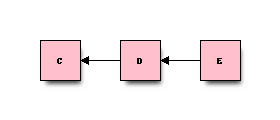
Since D was dependent on C, it is not clear whether D’s failure is the result of a defect in D or C:
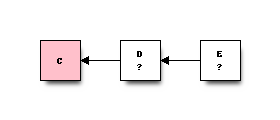
Since C failed, Zuul will report its failure and drop C from the queue, keeping D and E:
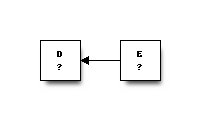
This queue is the same as if two new changes had just arrived, so Zuul starts the process again testing D against the tip of the branch, and E against D:
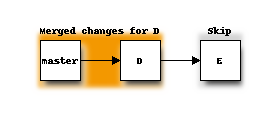
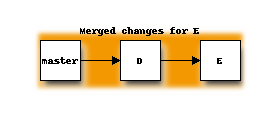
Cross Project Testing
When your projects are closely coupled together, you want to make sure changes entering the gate are going to be tested with the version of other projects currently enqueued in the gate (since they will eventually be merged and might introduce breaking features).
Such relationships can be defined in Zuul configuration by placing projects in a shared queue within a dependent pipeline. Whenever changes for any project enter a pipeline with such a shared queue, they are tested together, such that the commits for the changes ahead in the queue are automatically present in the jobs for the changes behind them. See Project for more details.
A given dependent pipeline may have as many shared change queues as necessary, so groups of related projects may share a change queue without interfering with unrelated projects. Independent pipelines do not use shared change queues, however, they may still be used to test changes across projects using cross-project dependencies.
Cross-Project Dependencies
Zuul permits users to specify dependencies across projects. Using a special footer, users may specify that a change depends on another change in any repository known to Zuul. In Gerrit based projects this footer needs to be added to the git commit message. In GitHub based projects this footer must be added to the pull request description.
Zuul’s cross-project dependencies behave like a directed acyclic graph (DAG), like git itself, to indicate a one-way dependency relationship between changes in different git repositories. Change A may depend on B, but B may not depend on A.
To use them, include Depends-On: <change-url> in the footer of a
commit message or pull request. For example, a change which depends
on a GitHub pull request (PR #4) might have the following footer:
Depends-On: https://github.com/example/test/pull/4
Note
For Github the Depends-On: footer must be in the Pull Request
description, which is separate and often different to the commit
message (i.e. the text submitted with git commit). This is in
contrast to Gerrit where the change description is always the
commit message.
A change which depends on a Gerrit change (change number 3):
Depends-On: https://review.example.com/3
Changes may depend on changes in any other project, even projects not on the same system (i.e., a Gerrit change may depend on a GitHub pull request).
Note
An older syntax of specifying dependencies using Gerrit change-ids is still supported, however it is deprecated and will be removed in a future version.
Dependent Pipeline
When Zuul sees changes with cross-project dependencies, it serializes them in the usual manner when enqueuing them into a pipeline. This means that if change A depends on B, then when they are added to a dependent pipeline, B will appear first and A will follow:
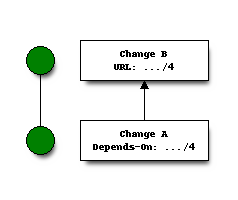
If tests for B fail, both B and A will be removed from the pipeline, and it will not be possible for A to merge until B does.
Note
If changes with cross-project dependencies do not share a change queue then Zuul is unable to enqueue them together, and the first will be required to merge before the second can be enqueued. If the second change is approved before the first is merged, Zuul can’t act on the approval and won’t automatically enqueue the second change, requiring a new approval event to enqueue it after the first change merges.
Independent Pipeline
When changes are enqueued into an independent pipeline, all of the related dependencies (both normal git-dependencies that come from parent commits as well as cross-project dependencies) appear in a dependency graph, as in a dependent pipeline. This means that even in an independent pipeline, your change will be tested with its dependencies. Changes that were previously unable to be fully tested until a related change landed in a different repository may now be tested together from the start.
All of the changes are still independent (you will note that the whole pipeline does not share a graph as in a dependent pipeline), but for each change tested, all of its dependencies are visually connected to it, and they are used to construct the git repositories that Zuul uses when testing.
When looking at this graph on the status page, you will note that the dependencies show up as grey dots, while the actual change tested shows up as red or green (depending on the jobs results):
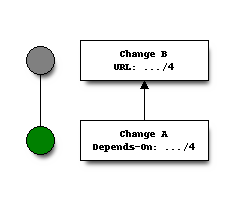
This is to indicate that the grey changes are only there to establish dependencies. Even if one of the dependencies is also being tested, it will show up as a grey dot when used as a dependency, but separately and additionally will appear as its own red or green dot for its test.
Multiple Changes
A change may list more than one dependency by simply adding more
Depends-On: lines to the commit message footer. It is possible
for a change in project A to depend on a change in project B and a
change in project C.
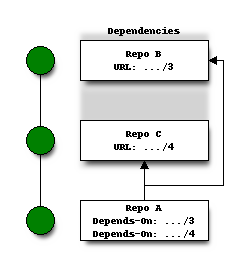
Cycles
If a cycle is created by use of cross-project dependencies, Zuul will abort its work very early. There will be no message in Gerrit and no changes that are part of the cycle will be enqueued into any pipeline. This is to protect Zuul from infinite loops.